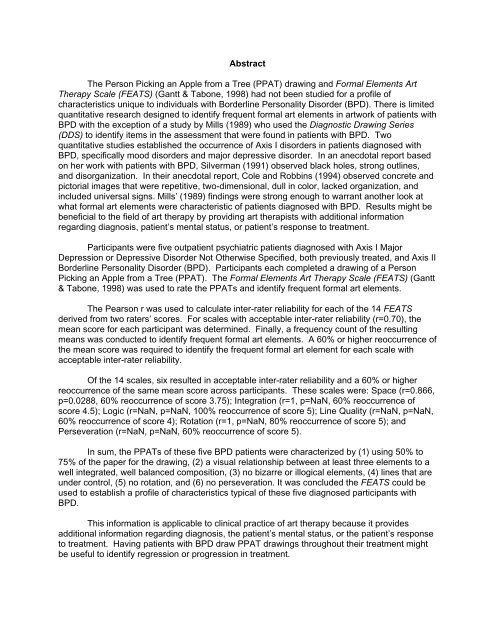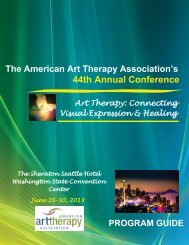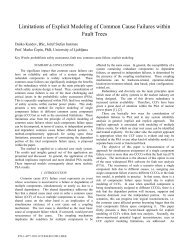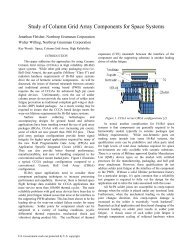Abstract The Person Picking an Apple from a Tree (PPAT) drawing ...
Abstract The Person Picking an Apple from a Tree (PPAT) drawing ...
Abstract The Person Picking an Apple from a Tree (PPAT) drawing ...
Create successful ePaper yourself
Turn your PDF publications into a flip-book with our unique Google optimized e-Paper software.
<strong>Abstract</strong><br />
<strong>The</strong> <strong>Person</strong> <strong>Picking</strong> <strong>an</strong> <strong>Apple</strong> <strong>from</strong> a <strong>Tree</strong> (<strong>PPAT</strong>) <strong>drawing</strong> <strong>an</strong>d Formal Elements Art<br />
<strong>The</strong>rapy Scale (FEATS) (G<strong>an</strong>tt & Tabone, 1998) had not been studied for a profile of<br />
characteristics unique to individuals with Borderline <strong>Person</strong>ality Disorder (BPD). <strong>The</strong>re is limited<br />
qu<strong>an</strong>titative research designed to identify frequent formal art elements in artwork of patients with<br />
BPD with the exception of a study by Mills (1989) who used the Diagnostic Drawing Series<br />
(DDS) to identify items in the assessment that were found in patients with BPD. Two<br />
qu<strong>an</strong>titative studies established the occurrence of Axis I disorders in patients diagnosed with<br />
BPD, specifically mood disorders <strong>an</strong>d major depressive disorder. In <strong>an</strong> <strong>an</strong>ecdotal report based<br />
on her work with patients with BPD, Silverm<strong>an</strong> (1991) observed black holes, strong outlines,<br />
<strong>an</strong>d disorg<strong>an</strong>ization. In their <strong>an</strong>ecdotal report, Cole <strong>an</strong>d Robbins (1994) observed concrete <strong>an</strong>d<br />
pictorial images that were repetitive, two-dimensional, dull in color, lacked org<strong>an</strong>ization, <strong>an</strong>d<br />
included universal signs. Mills’ (1989) findings were strong enough to warr<strong>an</strong>t <strong>an</strong>other look at<br />
what formal art elements were characteristic of patients diagnosed with BPD. Results might be<br />
beneficial to the field of art therapy by providing art therapists with additional information<br />
regarding diagnosis, patient’s mental status, or patient’s response to treatment.<br />
Particip<strong>an</strong>ts were five outpatient psychiatric patients diagnosed with Axis I Major<br />
Depression or Depressive Disorder Not Otherwise Specified, both previously treated, <strong>an</strong>d Axis II<br />
Borderline <strong>Person</strong>ality Disorder (BPD). Particip<strong>an</strong>ts each completed a <strong>drawing</strong> of a <strong>Person</strong><br />
<strong>Picking</strong> <strong>an</strong> <strong>Apple</strong> <strong>from</strong> a <strong>Tree</strong> (<strong>PPAT</strong>). <strong>The</strong> Formal Elements Art <strong>The</strong>rapy Scale (FEATS) (G<strong>an</strong>tt<br />
& Tabone, 1998) was used to rate the <strong>PPAT</strong>s <strong>an</strong>d identify frequent formal art elements.<br />
<strong>The</strong> Pearson r was used to calculate inter-rater reliability for each of the 14 FEATS<br />
derived <strong>from</strong> two raters’ scores. For scales with acceptable inter-rater reliability (r=0.70), the<br />
me<strong>an</strong> score for each particip<strong>an</strong>t was determined. Finally, a frequency count of the resulting<br />
me<strong>an</strong>s was conducted to identify frequent formal art elements. A 60% or higher reoccurrence of<br />
the me<strong>an</strong> score was required to identify the frequent formal art element for each scale with<br />
acceptable inter-rater reliability.<br />
Of the 14 scales, six resulted in acceptable inter-rater reliability <strong>an</strong>d a 60% or higher<br />
reoccurrence of the same me<strong>an</strong> score across particip<strong>an</strong>ts. <strong>The</strong>se scales were: Space (r=0.866,<br />
p=0.0288, 60% reoccurrence of score 3.75); Integration (r=1, p=NaN, 60% reoccurrence of<br />
score 4.5); Logic (r=NaN, p=NaN, 100% reoccurrence of score 5); Line Quality (r=NaN, p=NaN,<br />
60% reoccurrence of score 4); Rotation (r=1, p=NaN, 80% reoccurrence of score 5); <strong>an</strong>d<br />
Perseveration (r=NaN, p=NaN, 60% reoccurrence of score 5).<br />
In sum, the <strong>PPAT</strong>s of these five BPD patients were characterized by (1) using 50% to<br />
75% of the paper for the <strong>drawing</strong>, (2) a visual relationship between at least three elements to a<br />
well integrated, well bal<strong>an</strong>ced composition, (3) no bizarre or illogical elements, (4) lines that are<br />
under control, (5) no rotation, <strong>an</strong>d (6) no perseveration. It was concluded the FEATS could be<br />
used to establish a profile of characteristics typical of these five diagnosed particip<strong>an</strong>ts with<br />
BPD.<br />
This information is applicable to clinical practice of art therapy because it provides<br />
additional information regarding diagnosis, the patient’s mental status, or the patient’s response<br />
to treatment. Having patients with BPD draw <strong>PPAT</strong> <strong>drawing</strong>s throughout their treatment might<br />
be useful to identify regression or progression in treatment.
References<br />
Cole, M. D., & Robbins, A. (1994). Diagnostic indicators in the artwork of borderline <strong>an</strong>d<br />
dissociative patients. In A. Robbins, (Ed.), A multi-modal approach to creative art<br />
therapy (pp. 124-140). Bristol, PA: Jessica Kingsley.<br />
G<strong>an</strong>tt, L., & Tabone, C. (1998). Formal Elements Art <strong>The</strong>rapy Scale: <strong>The</strong> rating m<strong>an</strong>ual.<br />
Morg<strong>an</strong>town, WV: Gargoyle Press.<br />
Mills, A. (1989). A statistical study of the formal aspects of the Diagnostic Drawing Series of<br />
borderline personality disordered patients, <strong>an</strong>d its context in contemporary art therapy.<br />
Unpublished master’s thesis, Concordia University, Montreal, Quebec, C<strong>an</strong>ada.<br />
Silverm<strong>an</strong>, D. (1991). Art psychotherapy: An approach to borderline adults. In H. B. L<strong>an</strong>dgarten,<br />
& D. Lubbers, (Eds.), Adult art psychotherapy: Issues <strong>an</strong>d applications (pp. 83-110).<br />
Philadelphia: Brunner/Mazel.












